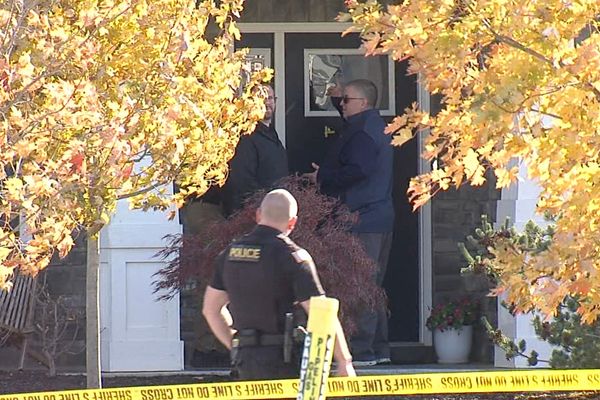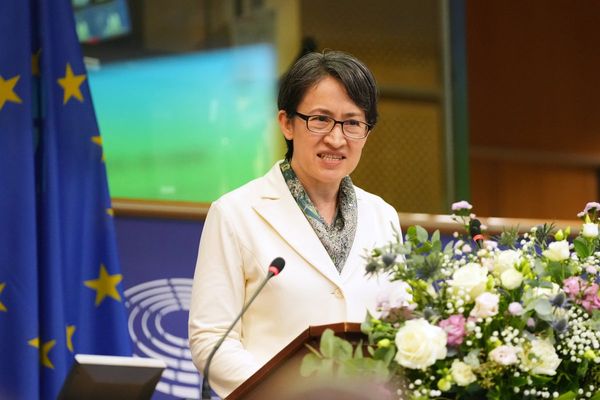
Lisa Price’s daughters chortle as they play in the empty cattle trough, before chasing each other across the paddocks that disappear into a cornflower blue horizon amid the rolling hills of central west New South Wales.
It’s exactly the kind of wholesome childhood scene that made Price decide to bring up her children on the farm that had been in her husband’s family for generations.
“I should be able to let them do that without feeling this level of anxiety, without this threat of long-term cognitive impacts. I shouldn’t be afraid of them playing outside.”
Her fears relate to a proposed lead mine next door. “We share nearly three kilometres of direct boundary fence and we are within the nominated two-kilometre radius of the proposed open cut pit.”
Many who live in the region, like Price, have family who work in the surrounding coalmines and are not against mining wholesale, but have concerns specifically about lead and its known toxicity for human health, particularly for children.
“As mothers, we measure risk very differently, because it’s our [children’s] lives on the line. There’s literally no economic argument that can outweigh that.”
Seeing the “terrifying situation” for families of Broken Hill, where half of children under five are suffering from elevated blood lead levels, Price says “you can’t help but watch that and feel very unprotected”.
‘As more of us realise, we are horrified’
Lead is a highly poisonous metal which can enter the body by breathing in dust or fumes, or ingesting it through food or drink. The World Health Organization says there is no safe level of human exposure to lead, which accumulates once it is in the body.
It is the “single chemical with by far the largest quantified health effects globally”, according to research published in the Lancet, affecting almost every organ and system in the body, and known to be especially dangerous for the development of babies in the womb and children.
A 2016 study of 127 children in the Australian lead mining towns of Port Pirie and Broken Hill demonstrated that any 10-fold increase in levels of lead in children’s blood (going from one microgram per decilitre to 10) was associated with a loss of 13.5 IQ points, with these results replicated in studies in other parts of the world.
Sign up: AU Breaking News email
Children under five are especially vulnerable to lead exposure, because they more often put their hands and objects to their mouth, they absorb and retain more lead from their gut and airways than adults, and their developing brains are more sensitive to its effects.
Prof Bruce Brew, a neurologist and director of the Peter Duncan Neurosciences Unit at St Vincent’s Centre for Applied Medical Research, says that as well as diminished intellect, increasing lead levels in children are also associated with behavioural disturbances and conditions including ADHD.
In adults, it is associated with cardiovascular disease, damage to the nerves in the arms and legs and cognitive impairment in older people, and some suspect it may be an additional factor in accelerating Alzheimer’s and other degenerative diseases, Brew says.
The mechanisms of toxicity aren’t well understood, but it is “partly disturbing our own genome”, Brew says.
The Bowdens Silver project, an open-cut silver, lead and zinc mine proposed on land near the village of Lue – 26km east of Mudgee – was granted approval in April 2023, then overturned a year later by the NSW court of appeal because the impact of its transmission line had not been assessed. The government changed planning laws in response to the decision, which has allowed Bowdens to apply for a redetermination of its application.
Like many in the community, when Price first heard the name Bowdens Silver project, she wasn’t too concerned, and did not realise lead was also going to be mined.
“I feel it was very much a tactic to make it seem less threatening.
“As more of us realise, we are horrified.”
A region at risk
Westerly winds blow through the valley where the mine site is proposed and would bring lead dust on to homes, vineyards and agricultural land in the towns of Lue, Rylstone and Kandos, while easterly winds would bring the lead dust to Mudgee, says Jayne Bentivoglio, CEO of Rylstone Olive Press and a spokesperson for the Mudgee Regional Health Alliance. She says the whole of the region is at risk, as lead dust has been shown to travel hundreds of kilometres.
A Bowdens Silver spokesperson says their assessment concluded that “our project presents no health risk issues of concern,” but an expert report commissioned by the alliance found that the mine had failed to address the environment watchdog’s concerns about its predicted emissions, relied on outdated evidence and that the community is rightly concerned for its health.
Bentivoglio says the community is not confident they will be protected from the threat of lead dust in the air, settling on the roofs of homes and going into rainwater tanks they rely on for drinking, as well as contaminating the food and wine the region is so well known for producing.
David Lowe, the director and chief winemaker of the Lowe Family Wine Co in Mudgee and spokesperson for the Mudgee Wine Association, says “whenever there’s lead mines around, they’re not bedfellows with agriculture and tourism”.
Lowe says they have seen the Environmental Protection Agency being “toothless” when it comes to the Cadia mine outside Orange, “so we see the inherent risk agriculturally with lead and water particularly”.
A NSW EPA spokesperson said an “extensive” air monitoring program was established in the Cadia region in 2023, with most heavy metal detections low. The EPA has also taken “strong action” against the mine’s operators including commencing charges and fines for air emissions offences, they said.
If the mine’s tailing dam is breached, it could affect the Lawson Creek it sits above, which joins the Cudgegong River, which runs through Lowe’s farm, Lowe says. The Cudgegong leads on to the Macquarie River, which leads on to the Murray Darling which “feeds everybody agriculturally from here all the way down to Adelaide,” Lowe says.
The tourism business that has boomed around agriculture in the region would also be stifled, Lowe says. At his winery, Lowe welcomed 43,000 people last year, but he says people will not want to come if Mudgee if the town joins the notorious ranks of Broken Hill and Mount Isa.
Grant Jessing, the president of the Mudgee Business Chamber, of which Bowdens Mine has membership, says the committee are in support of the mine going forward because it generates business opportunity and contractual opportunities for local businesses. Jessing, who is also the managing director at Straight Up Cranes and Rigging, says his business is one in the town that sees the mine as beneficial.
“There’s a big downturn in the coal industry at the moment, which is financially impacting our town here in Mudgee, and if we had another form of mining – and silver has gone up approximately 35% in the last 12 months – it’d be a much more valuable industry.
“It’s such a rich deposit of silver within Australia … I feel that the benefits would outweigh anything to do with the concerns of the community, and the regulator would shut it down immediately if there was anything untoward or un-environmentally correct.”
A Bowdens Silver spokesperson says the project has community support, which is “underpinned by a detailed environmental, social and economic assessment of the project that has gone through significant, transparent and thorough independent professional reviews by industry experts and government”.
‘Impossible to trust that safety is coming first’
At the big food festival next week, Flavours of Mudgee, Lowe says they will be attempting to raise awareness of the looming threat.
“We’ve been very slow to come to the realisation … but it’s only now when we started to find that some of the data has been suppressed, and started to talk to locals about it, they’re all picking their ears up,” Lowe says.
The environment watchdog buried a report for four years which found that emissions from contemporary lead mining in Broken Hill was a “leading source” of why half of children under five in the town have elevated blood lead levels. It was suppressed during the time of Bowden mine’s original application and a subsequent parliamentary inquiry into the mine.
Price says: “It really makes it impossible for us as parents to trust that our children’s safety is coming first.
“As a mother, I feel like I should never have to wonder if the government is protecting my children or protecting a mining company’s profits instead.”
Dr Cynthia Barlow, co-author of the suppressed Broken Hill report and author of the alliance’s commissioned report, says Australia needs to implement stronger regulations when it comes to lead, including trigger levels for the deposited dust, as well as consider lowering thresholds for what is considered normal background lead exposure in line with other international jurisdictions.
Without confidence in the government’s ability to protect them from serious health impacts, the effects on the community are already being felt.
NSW planning minister Paul Scully said the situation in Broken Hill is not comparable to the Bowdens mine due to decades of unregulated mining there. He said the Bowdens mine “underwent a full and thorough assessment and has strict monitoring requirements” though he did not address issues raised in Barlow’s report regarding outdated evidence and factual errors.
Lara Altimira lives next door to Lue public school but has chosen to send her daughter to school in the neighbouring town of Rylstone. If the mine was given approval, Altimira didn’t want to have to change her daughter’s school mid-year.
The more she has attended community meetings, the more concerned she has become. While her partner’s family all live in the area, she cannot imagine how they could continue living the lives they do – drinking tank water, growing vegetables, and spending time outside. “We would definitely need to leave.”
Price says a lot of her neighbours have already moved away. If the mine is granted approval, her family would be left with the “daunting” choice of attempting to coexist with the lead mine or selling their home, the historic 1860 stone cottage they spent years lovingly renovating.
“It’s cast a very long shadow across our little community, like a cloud of apprehension, anxiety and mental stress that lingers. It lingers in every person’s subconscious, and it lingers in every conversation you’re having with your neighbours.”
Read more:







